Get Pushy with Twilio to Win This Week's Developer Contest
Time to read:
This post is part of Twilio’s archive and may contain outdated information. We’re always building something new, so be sure to check out our latest posts for the most up-to-date insights.


Where do I start?
There are a lot of ways you could integrate Twilio with push features. You can subscribe to events to notify your app that then takes action using Twilio on those events. There’s also the inverse, taking events that happen in your Twilio apps and pushing notifications elsewhere. For instance you could notify a web browser based on actions taken within a phone call. Use your creativity to build a great push-enabled Twilio app and you could win an Amazon Kindle 3G, a leather case with built-in light and $100 in Twilio credit.
What should I use?
If you’re new to push technologies there are services out there that can help get you started. For publishing messages to a browser, check out Kwikka, Pusher, Orbited, or Socket.IO. All of these services support real-time messaging to the browser using some or all of the most commonly supported browser push technologies like WebSockets, Adobe Flash Sockets, AJAX long polling, JSONP polling and more. There’s also a lot of options for pushing data to mobile devices with iPhone, Android and Windows Phone all supporting powerful notification APIs.
How about on the server?
On the server side, technologies like node.js make it easy to publish real-time event data. node.js works well with Socket.IO and has spawned some additional frameworks like Faye to make building real-time apps even easier. If you’re a Google App Engine user, check out the recently released Google App Engine Channel API. Some other services that might work for your app are Amazon’s Simple Notification Service or, if you’re into PubSubHubbub, Superfeedr which recently added support for Comet and WebSockets. Lastly there’s our favorite push technology: good ol’ fashioned WebHooks.
Start Building!
So many options available! Hopefully this gives you some good ideas for getting started on your app. If you need more inspiration or need help while building your entry, check out our Forums and we’ll be glad to help.
This contest ends Sunday December 19th at 11:59pm PT. Complete information on how to enter can be found on the Twilio contests page.
Photo courtesy of Wikipedia
Related Posts
Related Resources
Twilio Docs
From APIs to SDKs to sample apps
API reference documentation, SDKs, helper libraries, quickstarts, and tutorials for your language and platform.
Resource Center
The latest ebooks, industry reports, and webinars
Learn from customer engagement experts to improve your own communication.
Ahoy
Twilio's developer community hub
Best practices, code samples, and inspiration to build communications and digital engagement experiences.


